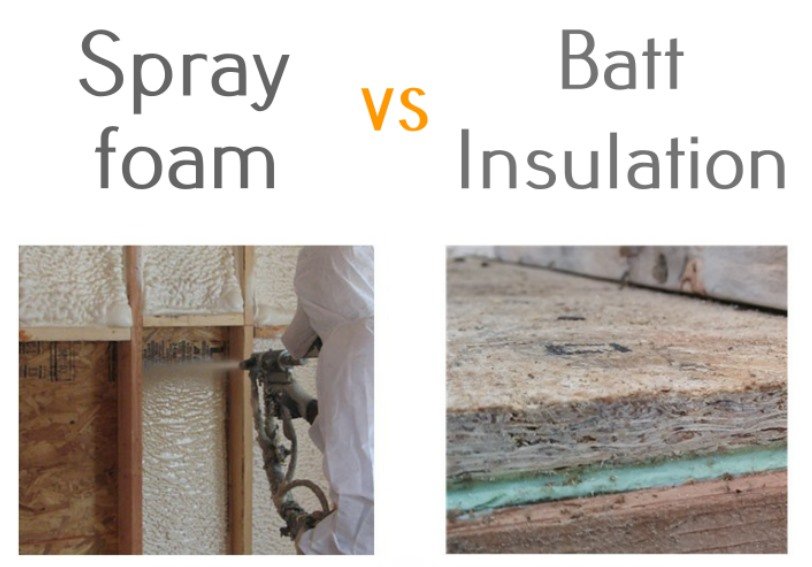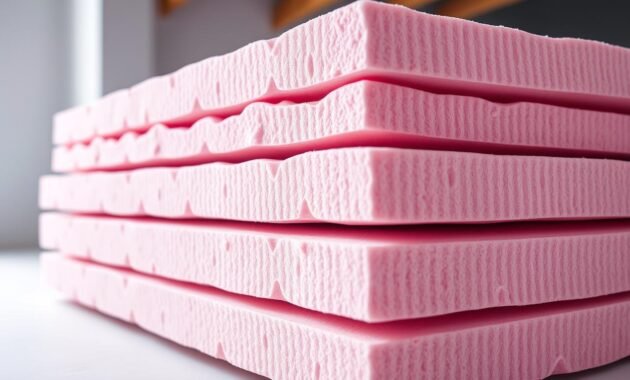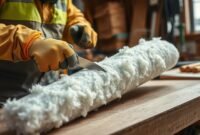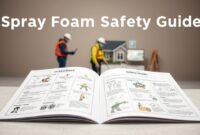Do you struggle with high energy bills and uncomfortable home temperatures? Many homeowners find it hard to pick the right insulation. Spray foam and batt insulation are often compared.
Choosing the wrong insulation can cost you a lot and make your home uncomfortable. I’ll help you understand the key differences between spray foam and batt insulation. This will help you make a smart choice that saves money and makes your home more comfortable.
My guide will cover everything from cost and installation to energy efficiency. You’ll learn how to pick the best insulation for your home.

Understanding Insulation Basics and Heat Transfer
Insulation is key to keeping spaces comfy and energy-smart. It stops unwanted temperature changes between inside and outside. This makes our homes cozy and saves energy.
Knowing about heat transfer helps us choose better insulation. Heat moves from warm to cool areas naturally. Good insulation slows this down, keeping homes warm in winter and cool in summer.
Read also: Soundproofing Spray Foam For Existing Walls
Decoding R-Value: The Insulation Performance Metric
R-value is like a superhero for insulation. It shows how well insulation blocks heat. The higher the R-value, the better it insulates. Here’s what you need to know:
- Measures thermal resistance
- Higher numbers mean better insulation
- Different for each material and thickness
- Important for saving energy costs
Exploring Insulation’s Noise Reduction Capabilities
Insulation does more than just control temperature. It also reduces noise. Various insulation types can greatly cut down sound, making homes quieter. Materials like spray foam and special batts block outside sounds, making spaces more peaceful.
How Insulation Materials Prevent Heat Transfer
Insulation types vary in how they stop heat transfer. Some trap air to slow heat, while others create solid barriers. The aim is always the same: keep indoor temperatures steady and save energy.
Spray Foam vs Batt Insulation: Key Differences
Choosing insulation for your home involves understanding the differences between spray foam and batt insulation. These options have unique features that affect their performance and installation. Knowing these differences helps you make a better choice.
Spray foam insulation is applied as a liquid that expands to fill gaps. This creates a tight seal. It can reach areas that batt insulation can’t, providing better coverage.
- Spray foam creates an instant air and moisture barrier
- Batt insulation requires precise cutting and fitting
- Spray foam expands to seal even the smallest cracks
- Batt insulation comes in pre-cut sections
The way you install these insulations is different too. Batt insulation needs to be carefully placed between studs and rafters. Spray foam, on the other hand, is sprayed directly onto surfaces, sealing air leaks automatically.
When it comes to energy efficiency, spray foam insulation is ahead. It has a higher R-value per inch, which means better thermal resistance. This leads to improved energy performance. While batt insulation is effective, it can’t match spray foam’s sealing abilities.
In the end, your choice between spray foam and batt insulation depends on your home improvement needs and budget. It also depends on your long-term energy efficiency goals.
Spray Foam Insulation: Material Properties and Types
Spray foam insulation is a top choice for making homes more energy-efficient. I’ll explain why it’s so effective at keeping your home warm and cozy.
Homeowners can choose between open-cell and closed-cell spray foam. Each has its own benefits for different needs.
Open-Cell vs Closed-Cell Spray Foam Characteristics
The main difference between open-cell and closed-cell spray foam is their density and how well they work:
- Open-cell spray foam is lighter and more flexible
- Closed-cell spray foam is stronger and more rigid
- Open-cell has a lower R-value (around 3.5 per inch)
- Closed-cell spray foam has a higher R-value (about 7 per inch)
Application Methods and Coverage
Spray foam insulation is made by mixing isocyanate and polyol resin at the spray gun’s tip. Experts use special tools to apply it evenly and cover the right areas.
| Spray Foam Type | R-Value | Moisture Resistance | Best Used In |
|---|---|---|---|
| Open-Cell Spray Foam | 3.5 per inch | Low | Interior walls, attics |
| Closed-Cell Spray Foam | 7 per inch | High | Exterior walls, basements |
Durability and Longevity Factors
Both open-cell and closed-cell spray foam are very durable. Closed-cell foam is stronger and better at keeping moisture out, perfect for tough spots.
Choosing the right spray foam insulation can make your home last 20-30 years. It beats traditional insulation in every way.
Batt Insulation: Composition and Characteristics

Foam batt insulation is a common choice for homes and businesses. It’s made from fiberglass, mixed with sand and recycled glass. This mix creates a strong barrier against heat.
This insulation has many benefits:
- Natural fire resistance
- Excellent sound dampening capabilities
- Cost-effective thermal protection
- Environmentally friendly manufacturing process
Fiberglass batt insulation comes in different sizes and thicknesses. These affect its R-value and how well it keeps heat out. Homeowners can pick the right density for their needs.
| Characteristic | Description |
|---|---|
| Material Composition | Sand, recycled glass fibers |
| Fire Resistance | Inherently non-combustible |
| Sound Absorption | Reduces noise transmission |
| R-Value Range | R-2.2 to R-4.3 per inch |
Even with its many benefits, foam batt insulation can settle. It’s important to check it now and then. Also, installing it right is key to keeping it effective and avoiding gaps.
Cost Analysis: Investment vs Long-term Value
Thinking about spray foam insulation? Homeowners need to weigh the costs. The first payment might be high, but the long-term gains could be worth it.
Let’s look at the money side of spray foam insulation. This will help you decide if it’s right for you.
Initial Installation Expenses
Spray foam insulation is pricier than old-school batts. Here’s what you might pay:
- Spray foam: $3 per square foot (for 3-inch thickness)
- Fiberglass batt: $0.40 per square foot
Energy Savings Comparison
Does spray foam save money on energy? Yes, it does. You could save enough to pay back the cost in 3-5 years.
| Insulation Type | Annual Energy Savings | Payback Period |
|---|---|---|
| Spray Foam | Up to 50% | 3-5 years |
| Fiberglass Batt | 20-30% | 7-10 years |
Maintenance and Replacement Costs
Spray foam lasts longer than other insulation. It doesn’t sag or settle like fiberglass batts. This means you’ll spend less on upkeep and replacements.
My advice? Think about your home, climate, and budget. Spray foam insulation might cost more upfront. But its long-term benefits make it a good choice for many looking to save energy and stay comfortable.
Installation Process and Requirements
Installing foam insulation can vary a lot between spray foam and batt insulation. Professional contractors have the skills and tools needed for a good job.
Spray foam insulation needs a lot of expertise because of its complex application. Experts use special spray guns that mix chemicals right at the tip. This requires a lot of skill and safety measures. The steps for installation are:
- Thorough area preparation and cleaning
- Protective gear for installers
- Precise chemical mixing
- Careful application technique
- Ensuring even coverage
Batt insulation is easier to install. DIY fans can try it, but getting it right takes focus. The steps for proper installation are:
- Measuring space accurately
- Cutting batts to fit precisely
- Avoiding compression
- Sealing possible air gaps
- Maintaining consistent coverage
I suggest getting pros for spray foam insulation for the best results. For batt insulation, DIY can work if you do your homework and follow the right steps.
Energy Efficiency and Performance Metrics
Understanding performance metrics is key when choosing home insulation. Spray foam insulation is a top choice for those wanting the best energy efficiency and protection.
I’ll explain why closed-cell spray foam is a standout insulation option.
Read also: How to Get Spray Foam Off Hands Quickly?
Thermal Resistance Ratings
Thermal resistance, or R-value, shows how well insulation stops heat transfer. Closed-cell spray foam is a top performer:
- It has a higher R-value per inch than other insulation
- Its R-value is usually between R-6 and R-7 per inch
- It creates a strong thermal barrier for homes
Air Sealing Capabilities
Closed-cell spray foam is great at sealing air tight. It has special properties that help:
- It expands to fill small cracks and gaps
- It can cut air infiltration by up to 50%
- It stops drafts and saves energy
Moisture Control Properties
Controlling moisture is vital for home protection. Closed-cell spray foam is excellent at it:
| Moisture Property | Closed-Cell Spray Foam Performance |
|---|---|
| Water Resistance | Highly water-resistant |
| Vapor Barrier | Acts as built-in vapor barrier |
| Mold Prevention | Inhibits moisture accumulation |
Choosing closed-cell spray foam boosts your home’s energy efficiency, comfort, and protection against the environment.
Environmental Impact and Safety Considerations
When we think about spray foam insulation, we must consider its environmental and safety aspects. Not all insulation materials are the same in terms of their ecological impact and health risks.
Spray foam insulation has big environmental benefits, despite some concerns. It helps save a lot of energy. This means homes use less power, which cuts down on carbon emissions and lowers energy costs.
- Reduces overall energy consumption by up to 30%
- Minimizes air leakage in building structures
- Provides long-term thermal performance
It’s important to think about safety when choosing spray foam insulation. Getting it installed by a pro is key to avoid health issues. Homeowners should hire certified contractors who know how to apply it right.
The chemical makeup of spray foam varies between open-cell and closed-cell types. Both are good insulators, but closed-cell foam is better for the environment. It’s a stronger moisture barrier and helps with the structure of your home.
- Open-cell spray foam: More breathable, lower density
- Closed-cell spray foam: Higher density, better moisture resistance
- Both types minimize indoor air quality concerns when properly installed
It’s wise to talk to environmental experts and professional installers. They can help you understand how spray foam insulation affects your home’s environment.
Conclusion
Choosing the right insulation is not simple. Every home is different, needing its own special solution. Spray foam is great for keeping energy in and air out. But batt insulation is cheaper and works well for some homes.
When deciding between spray foam and batt insulation, think about a few things. How much you can spend, your home’s age, the weather, and saving energy for the future are all important. Spray foam might be pricier but saves money in the long run. Batt insulation is a good choice if you want to save money right away.
The climate and how your home is built also matter. In very hot or humid places, spray foam is better. But if you’re watching your budget or have simpler needs, batt insulation might be best. It’s all about knowing what your home needs and picking the right insulation for it.
Really, good insulation makes your home cozy and saves energy. Whether you pick spray foam or batt insulation, make sure it’s installed right. A pro can help your home stay warm in winter and cool in summer, saving you money over time.


